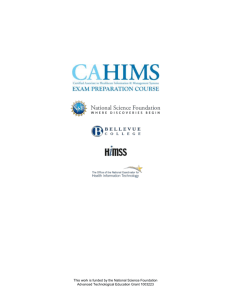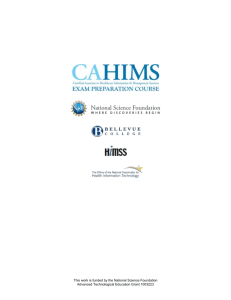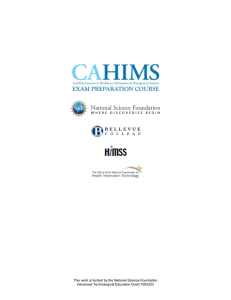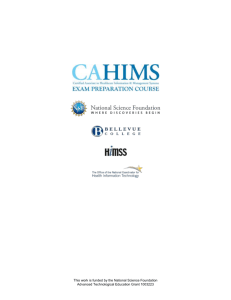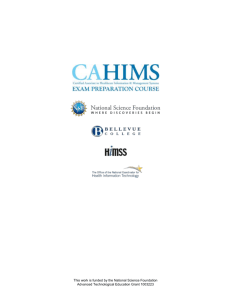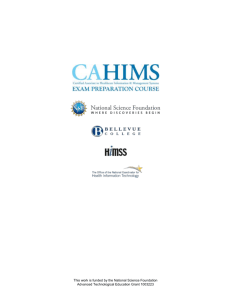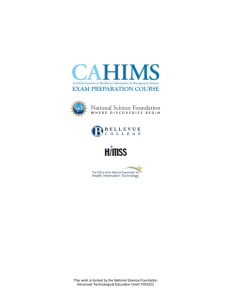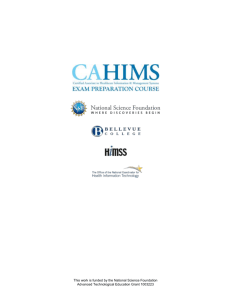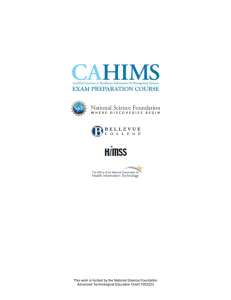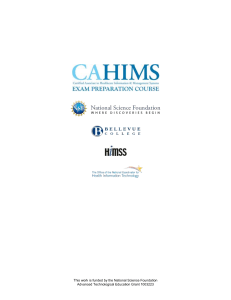8.3-Assessment-Key
advertisement
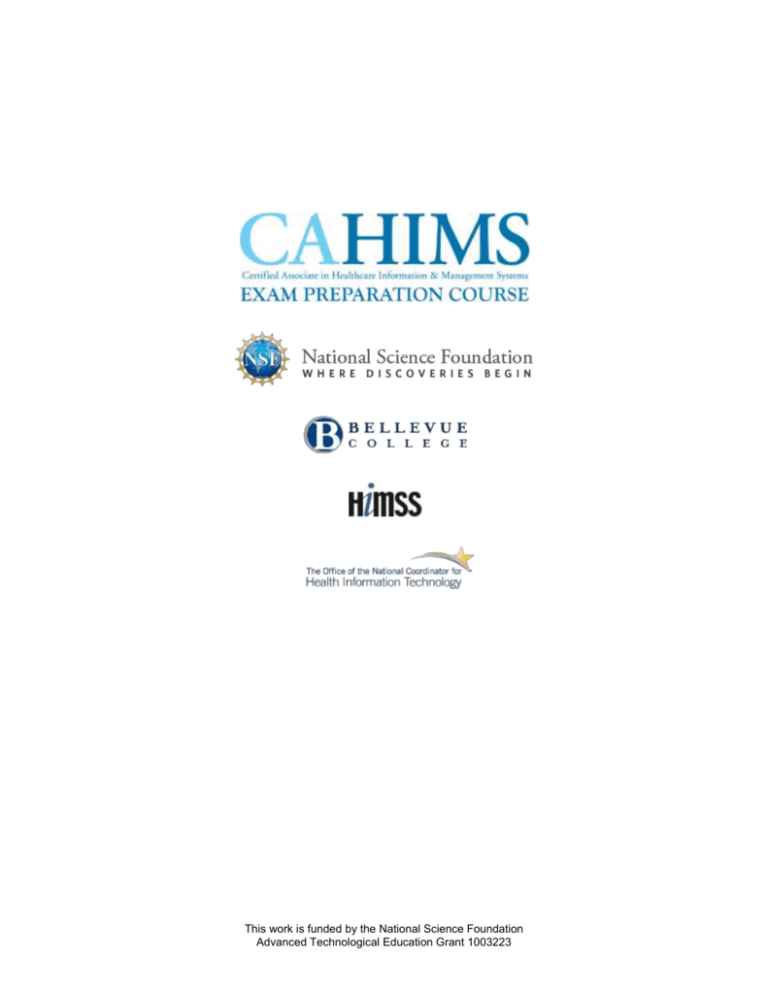
This work is funded by the National Science Foundation Advanced Technological Education Grant 1003223 The CAHIMS Exam Preparation Course and the CAHIMS exam are the result of collaboration between the Life Science Informatics Center at Bellevue College and the Healthcare Information and Management Systems Society (HIMSS). Significant content found in the CAHIMS Exam Preparation Course stems from the Office of the National Coordinator for Health Information Technology. Creation of the CAHIMS Exam Preparation Course and the CAHIMS exam was made possible through support from the National Science Foundation (NSF). Curriculum Team: Margaret Schulte, DBA Michèle Royer, PhD Nathan Savage, MLIS This work is funded by the National Science Foundation Advanced Technological Education Grant 1003223 Section 8 - Leadership and Planning Lesson 8.3 - IT Strategic Planning Assessment Questions Answer Key Lectures 1 & 2 1. IT Governance Structures are important because a. they tell everyone what to do. b. they replace the planning process. *c. they define roles and responsibilities at every level of the organization. d. they make people at all people feel included. Answer: c. they define roles and responsibilities at every level of the organization. Lecture(s)/Slide(s): 2/10 2. Prioritizing HIT Goals is important for all but which of the following reasons? a. It helps an organization see where all of the IT investments are currently being made b. It makes the entire organization think about IT alignment. c. It helps leadership think about IT in terms of a utility, not a department *d. It helps the IT department determine who they most want to assist. Answer: d. It helps the IT department determine who they most want to assist. Lecture(s)/Slide(s): 2/10 3. Taking a “Best of Breed” approach to technology purchase and adoption can be defined as: *a. Selecting the top of the line system for each department. b. Integration of the best performing systems in an organization. c. A system that allows data duplication. d. Selecting the best system an organization’s money can buy. Answer: a. selecting the top of the line system for each department. Lecture(s)/Slide(s): 2/11 This work is funded by the National Science Foundation Advanced Technological Education Grant 1003223 Page 1 4. A single system or “integrated” system refers to a. A system that meets the needs of everyone in the organization. b. A system that works with all existing systems at an organization. *c. A system where one vendor supplies most or all of the organizational applications. d. A system known as a “behemoth”. Answer: c. A system where one vendor supplies all or most of applications in an organization. Lecture(s)/Slide(s): 2/12 5. When prioritizing existing IT Projects vs. new EHR implementations, a question that should not be a major driver in the decision making process is: a. What is the greatest organizational priority? b. Of the external priorities the organization has, which has the most far-reaching implications? c. Why would I implement this technology now? *d. Will the ROI of the EHR pay off? Answer: d. Will the ROI of the EHR pay off? Lecture(s)/Slide(s): 2/6 6. The difference between a tactical plan and a strategic plan is: a. Personnel requirements b. Budgets c. Project descriptions *d. Scope Answer: d. Scope Lecture(s)/Slide(s): 2/3 This work is funded by the National Science Foundation Advanced Technological Education Grant 1003223 Page 2 7. The internal information systems assessment include all but which of the following? a. Current, completed, and immediately planned projects *b. Current organizational mode c. Current staffing status d. Current supported systems, scheduled upgrades and sunsettings Answer: b. Current organizational mode Lecture(s)/Slide(s): 1/10 8. Response to Medicaid and Medicare incentives is largely determined during which phase of the Strategic Planning Process? *a. Business Objectives/Strategy Alignment b. Organizational Strategy c. Internal IS Assessment d. Business Case Development Answer: a. Business Objectives/Strategy Alignment Lecture(s)/Slide(s): 1/10 9. A key benefit of planning IT investments is: a. Increased quantity of IT projects b. Decrease overall cost for IT projects *c. Managing expectations d. Selection of comprehensive IT projects Answer: c. Managing expectations Lecture(s)/Slide(s): 1/16 This work is funded by the National Science Foundation Advanced Technological Education Grant 1003223 Page 3 10. In regards to the role of a HIT Implementation manager, which is NOT a benefit of studying the organization’s Information Technology Strategic Plan? a. Understanding the objectives of the IT department b. Understanding the goals of the healthcare organization *c. Understanding the passions of the stakeholders d. Gaining additional input to produce a better quality product Answer: c. Understanding the passions of the stakeholders Lecture(s)/Slide(s): 1/20 11. Which unit of the IT Governance Model is responsible for providing questions and answers about IT regulations and overseeing regulatory compliance? a. Sources of IT Demands *b. IT Governing Bodies c. Program Management Office d. IT Executive Steering Committee Answer: b. IT Governing Bodies Lecture(s)/Slide(s): 2/9 12. In regards to obtaining IT needs, the IT Governance Model provides a/an: a. Policies b. Corporate pay and benefit schedule c. Foundation *d. Infrastructure Answer: d. Infrastructure Lecture(s)/Slide(s): 2/10 This work is funded by the National Science Foundation Advanced Technological Education Grant 1003223 Page 4 13. The IT lifecycle is important because a. it's the right thing to do. b. the CEO mandates it. *c. it helps support organizational goals. d. it is a federal requirement. Answer: c. it helps support organizational goals. Lecture(s)/Slide(s): 1/7 14. In IT planning in mature organizations, which of the following is NOT true? a. IT planning had no beginning or end b. IT plan emphasized themes rather than initiatives c. IT was not thought of as a separate process *d. IT planning was haphazard Answer: d. IT planning was haphazard Lecture(s)/Slide(s): 1/17 15. Which of the following is NOT a common pitfall of prioritizing IT investments? a. Belief that expectations will be aligned across departments *b. Understanding that not all IT Projects can be funded c. Lack of an organizational decision making team d. Lack of IT governance structure Answer: b. Understanding that not all IT Projects can be funded Lecture(s)/Slide(s): 1/13 This work is funded by the National Science Foundation Advanced Technological Education Grant 1003223 Page 5 16. The Strategic Information Systems Plan (IT Plan. is a corporate document based on all of the following EXCEPT a. clinical needs of the organization. b. known IT initiatives. c. risk-appropriate priorities. *d. technology projections. Answer: d. technology projections Lecture(s)/Slide(s): 1/3 17. In IT terms, when a system becomes obsolete or needs to be replaced, it’s said to be: *a. sun-setted b. brought down c. eighty-sixed d. finished Answer: a. sun-setted Lecture(s)/Slide(s): 1/8 This work is funded by the National Science Foundation Advanced Technological Education Grant 1003223 Page 6
